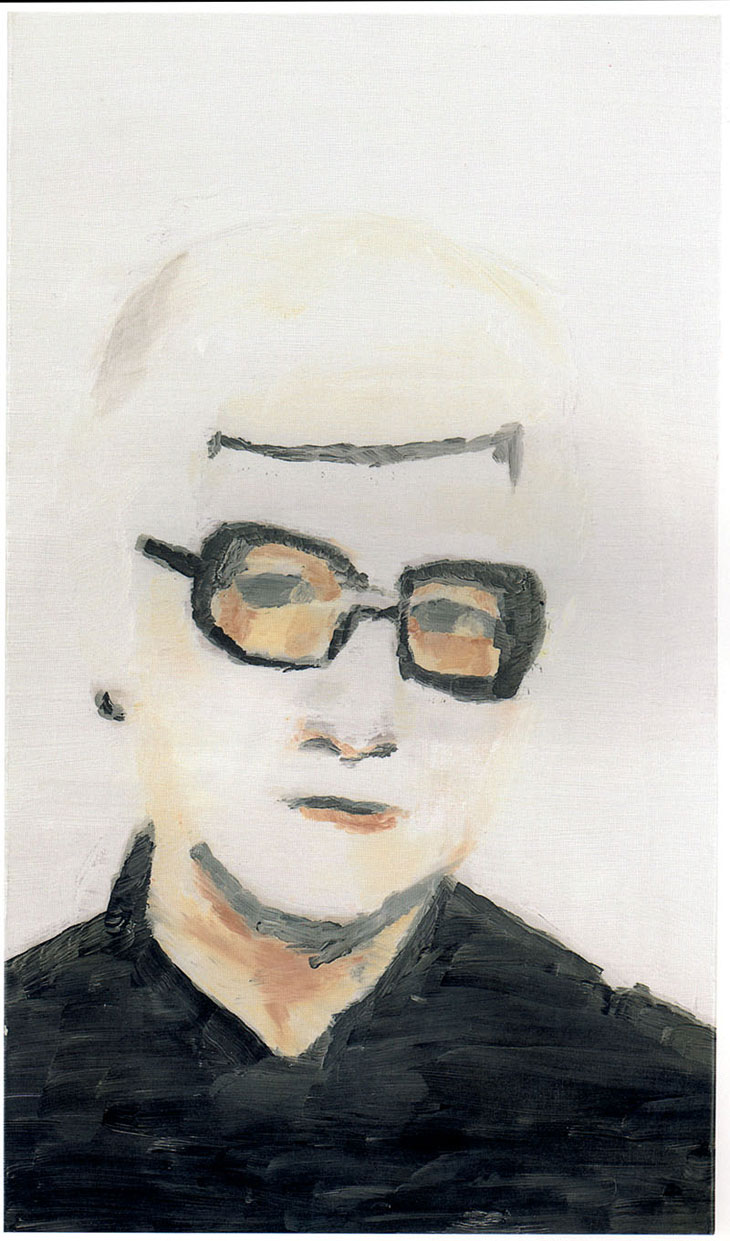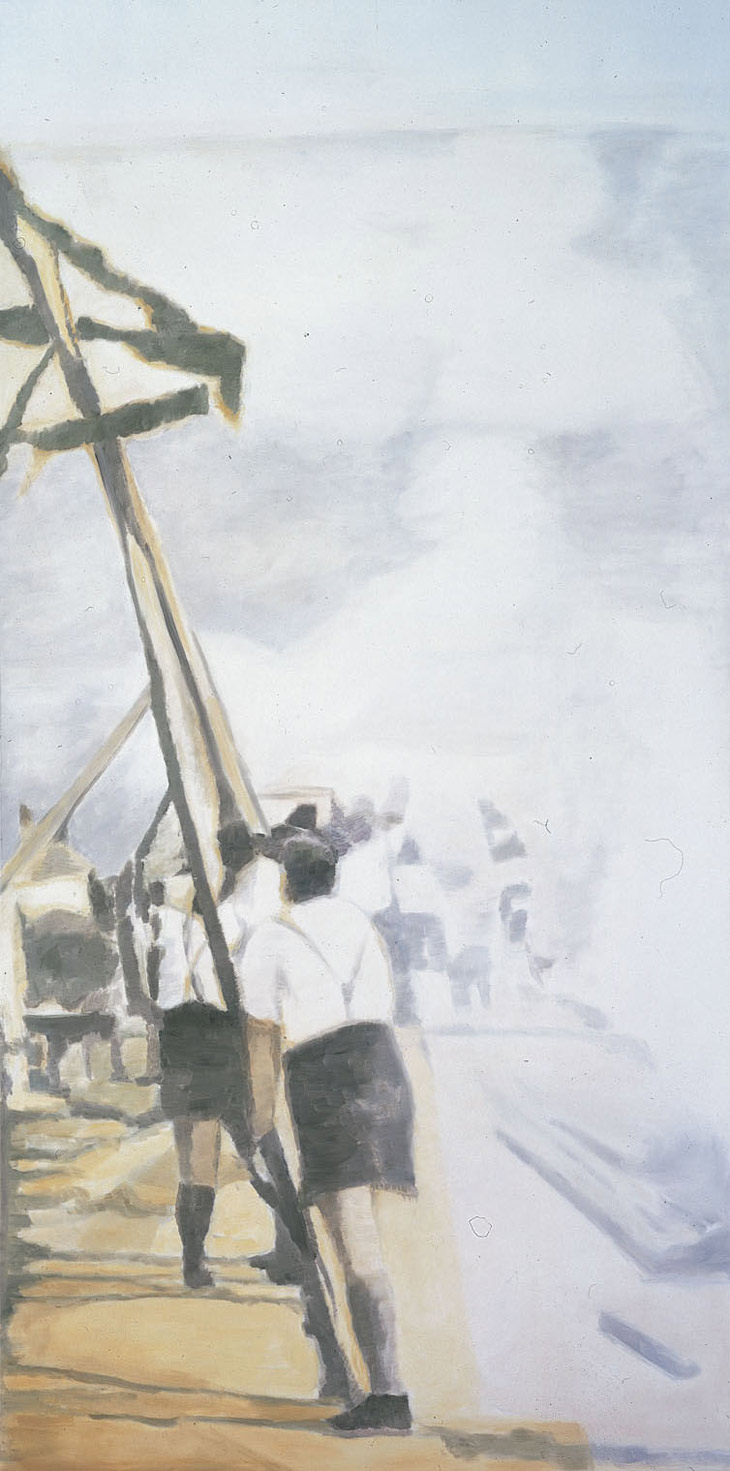




ARTIST:
Luc Tuymans
Ritual and tradition play a large part in Luc Tuymans’s work, drawing on the solace in repetition, the blind faith of unquestioned custom. Taken from a funerary tribute photo, the type of memento circulated to grieving loved ones in Luc Tuymans’s native Belgium, Portrait is an image of both commemoration and inconsequence. The woman’s melancholic expression and sickly pallor serve less as a reminder of a vibrant life, than a lingering forbearance of death; her cherished memory a mere ghost - faded and shrinking, as if she never was. Only her black dress and glasses remain, sinister and anonymous props, lonely relics without sentiment or intimacy.
Luc Tuymans paints the indescribable. His dark muted scenes seem vaguely familiar, distant, like haunting memories. Drawing his inspiration from grand themes, Luc Tuymans taps into a universal social guilt: from the Holocaust, or imperialism, to child abuse. By minimalising his images, he creates a raw emotion through paint; each painting linking spiritually, somehow instinctively, to the rest.
Within is a tranquil vermin metaphor for contamination and disease. A close-up detail of a birdcage, this painting more than conveys feelings of hopelessness and isolation: through its sheer size and potency, it literally traps the viewer, swallowing him into a prison of collective consciousness. If media images inadequately depict the horrors of reality, then Luc Tuymans’s paintings are even more disturbingly detached. Often taking his imagery from published photos (of war, violence, subjugation), the paintings are the antithesis of this historic iconography: dull tones, vague, nondescript scenes, stripped of emotional propaganda.
Maypole suggests only the mistiest remnants of a memory: men in lederhosen raising a mast (Cross?), with flags waving in the distance, they could be scouts, pioneers, morris dancers or Hitler Youth. Though it’s painted with the faded language of nostalgia, Maypole is strangely empty: void of sympathy or moral, Luc Tuymans renders a scene twice-removed, making it impulsively human. Without context of history or source, the viewer is left to engage with the painting on a purely instinctive level; being drawn into the evils of history, he adopts his own role as a silent and willing observer. Exposing the gap between represented image and historical event, Luc Tuymans’s paintings delve into the inner workings of how mythology is created. The reality of Luc Tuymans’s work is almost ’twee’, pleasing images of a lampshade or leopard-skin rug pass quite comfortably as aesthetic totems; it’s only their cognitive association with the Holocaust, or atrocities of the Belgian Congo, that encapsulates the true banality of evil - the unspeakable horror in a teacup, the monstrous potential of an empty bath. Luc Tuymans’s paintings consciously fall desperately short of the iconic, becoming vestiges posed as counterfeit emblems for that which cannot be conveyed.
Still Life is a monument to this inadequacy of language. Made initially for the 2002 Documenta, Luc Tuymans was expected to present paintings of images relating to 9/11 to coincide with the exhibition’s theme of political and social engagement. What he decided to show was a giant still life. The sheer scale makes the contemplation of this painting almost impossible: a vast canvas representing an absolute nothingness. Luc Tuymans chose the subject of still life precisely because it was utterly unremarkable; a generic ’brand’ of ’object’ rendered to immense scale; it is banality expanded to the extreme. The simplicity of Luc Tuymans’s composition alludes to a pure and uninterrupted world order; the ephemeral light, with which the canvas seems to glow, places it as an epic masterpiece of metaphysical and spiritual contemplation. In response to unimaginable horror, Luc Tuymans offers the sublime. A gaping magnitude of impotency, which neither words nor paintings could ever express. Luc Tuymans’s pigeons bop in dumb disarray. Dirty and disease-ridden, they’re a strangely curious mob, a metaphoric stand-in for ourselves. Painted in the muted tones of history, Luc Tuymans offers a chilling ultimate truth about humankind. He makes a cold comedy of a terrifying thought.
Within is a tranquil vermin metaphor for contamination and disease. A close-up detail of a birdcage, this painting more than conveys feelings of hopelessness and isolation: through its sheer size and potency, it literally traps the viewer, swallowing him into a prison of collective consciousness. If media images inadequately depict the horrors of reality, then Luc Tuymans’s paintings are even more disturbingly detached. Often taking his imagery from published photos (of war, violence, subjugation), the paintings are the antithesis of this historic iconography: dull tones, vague, nondescript scenes, stripped of emotional propaganda.
Maypole suggests only the mistiest remnants of a memory: men in lederhosen raising a mast (Cross?), with flags waving in the distance, they could be scouts, pioneers, morris dancers or Hitler Youth. Though it’s painted with the faded language of nostalgia, Maypole is strangely empty: void of sympathy or moral, Luc Tuymans renders a scene twice-removed, making it impulsively human. Without context of history or source, the viewer is left to engage with the painting on a purely instinctive level; being drawn into the evils of history, he adopts his own role as a silent and willing observer. Exposing the gap between represented image and historical event, Luc Tuymans’s paintings delve into the inner workings of how mythology is created. The reality of Luc Tuymans’s work is almost ’twee’, pleasing images of a lampshade or leopard-skin rug pass quite comfortably as aesthetic totems; it’s only their cognitive association with the Holocaust, or atrocities of the Belgian Congo, that encapsulates the true banality of evil - the unspeakable horror in a teacup, the monstrous potential of an empty bath. Luc Tuymans’s paintings consciously fall desperately short of the iconic, becoming vestiges posed as counterfeit emblems for that which cannot be conveyed.
Still Life is a monument to this inadequacy of language. Made initially for the 2002 Documenta, Luc Tuymans was expected to present paintings of images relating to 9/11 to coincide with the exhibition’s theme of political and social engagement. What he decided to show was a giant still life. The sheer scale makes the contemplation of this painting almost impossible: a vast canvas representing an absolute nothingness. Luc Tuymans chose the subject of still life precisely because it was utterly unremarkable; a generic ’brand’ of ’object’ rendered to immense scale; it is banality expanded to the extreme. The simplicity of Luc Tuymans’s composition alludes to a pure and uninterrupted world order; the ephemeral light, with which the canvas seems to glow, places it as an epic masterpiece of metaphysical and spiritual contemplation. In response to unimaginable horror, Luc Tuymans offers the sublime. A gaping magnitude of impotency, which neither words nor paintings could ever express. Luc Tuymans’s pigeons bop in dumb disarray. Dirty and disease-ridden, they’re a strangely curious mob, a metaphoric stand-in for ourselves. Painted in the muted tones of history, Luc Tuymans offers a chilling ultimate truth about humankind. He makes a cold comedy of a terrifying thought.




